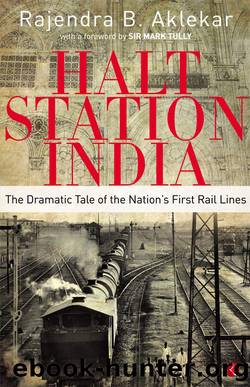HALT STATION INDIA: THE DRAMATIC TALE OF THE NATION’S FIRST RAIL LINES by Rajendra B. Aklekar

Author:Rajendra B. Aklekar [Aklekar, Rajendra B.]
Language: eng
Format: epub
ISBN: 9788129134974
Publisher: Rupa Publications Private Limited
Published: 2015-01-06T18:30:00+00:00
Decorative Work Near Sion Station’s Roof
Parallel to the rail line, close to N.S. Mankikar Road, lies an undocumented 200-year-old milestone, dating back to 1817. Discovered by a group of college students during one of their projects, the milestone bears the inscription ‘IX miles from St Thomas’. A bit ahead on the same road lies an octagonal solid structure that many say belongs to the era of the Second World War. It is a garrison, probably used to store ammunition, now maintained as a family dwelling. Treasures indeed!
KURLA STATION: SALT AND SHALLOW CREEKS
The line moves out of Sion Station. When the lines had been built, the topography of the area had been entirely different. There was no Eastern Express Highway, but smaller roads leading to the village of Chembur and the Central Salsette Tramway. There was no Kurla East, only a vast expanse of salt pans.
The oldest relic that used to exist (until recently), just after Sion Station, was an enormous 129-foot-long iron mast, holding overhead wires and spanning across all eight tracks. Reporting on the inauguration of the first electric railway in India between Victoria Terminus and Kurla, the GIP Railway Magazine of 1925 had said that this particular mast had the largest traction span in the world at that time. The massive gantry stood out amidst the single poles like a crown over the eight lines. But it was unceremoniously pulled down one night in the recent past, cut into pieces and carted away to be sold as scrap, paving way for new technology.
As the line moves ahead, an abandoned stone cabin without a roof is found hidden behind overgrown bushes. These are remains of an old level-crossing that was once located here, near the old Swadeshi Mill premises. Further ahead, at what is called the Sarveshwar Mahadev Temple junction, a footbridge with stone ramps passes over the line. This is, according to railway records, one of the oldest existing footbridges, built around 1904, with wrought iron lamps and balustrades. It faces the tracks, and possibly exists for those who love the simple pleasure of train spotting.
The Sarveshwar Mahadev Temple was built in 1883, thirty years after the first rail run, on land donated to workers of Swadeshi Mill and Kurla Spinning Mill by the Wadia Trust, so they could have a place of worship. Interestingly, the temple’s archives mention that the old Kurla Station was originally located opposite this very temple.
As trains approach today’s Kurla Station, they pass small hillocks blanketed with makeshift dwellings. In fact, when the first line was being laid, archives suggest that the land between Kurla Station and Ghatkopar had a small chain of mountains and salt pans. These mountains had to be cut to make way for a double line. To date, the old Kurla Village road, parallel to the railway line, is at a gradient, harking back to the erstwhile ridge.
An abandoned and solitary platform, just before Kurla Station, is a legacy of the old salt trade that once flourished here. It witnessed the conveyance of salt from the pans to the city.
Download
This site does not store any files on its server. We only index and link to content provided by other sites. Please contact the content providers to delete copyright contents if any and email us, we'll remove relevant links or contents immediately.
| Automotive | Engineering |
| Transportation |
Small Unmanned Fixed-wing Aircraft Design by Andrew J. Keane Andras Sobester James P. Scanlan & András Sóbester & James P. Scanlan(32763)
Navigation and Map Reading by K Andrew(5132)
Endurance: Shackleton's Incredible Voyage by Alfred Lansing(4715)
And the Band Played On by Randy Shilts(2163)
The Box by Marc Levinson(1964)
Top 10 Prague (EYEWITNESS TOP 10 TRAVEL GUIDES) by DK(1956)
Wild Ride by Adam Lashinsky(1950)
The Race for Hitler's X-Planes: Britain's 1945 Mission to Capture Secret Luftwaffe Technology by John Christopher(1836)
The One Percenter Encyclopedia by Bill Hayes(1811)
Trans-Siberian Railway by Lonely Planet(1725)
Girls Auto Clinic Glove Box Guide by Patrice Banks(1706)
Bligh by Rob Mundle(1675)
Looking for a Ship by John McPhee(1651)
Good with Words by Patrick Barry(1639)
Batavia's Graveyard by Mike Dash(1632)
TWA 800 by Jack Cashill(1625)
Fighting Hitler's Jets: The Extraordinary Story of the American Airmen Who Beat the Luftwaffe and Defeated Nazi Germany by Robert F. Dorr(1610)
Troubleshooting and Repair of Diesel Engines by Paul Dempsey(1577)
Ticket to Ride by Tom Chesshyre(1566)
